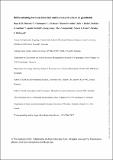Differentiating between inherited and autocrystic zircon in granitoids
Abstract
Inherited zircon, crystals that did not form in situ from their host magma but were incorporated from either the source region or assimilated from the wall-rock, is common but can be difficult to identify. Age, chemical and/or textural dissimilarity to the youngest zircon fraction are the primary mechanisms of distinguishing such grains. However, in Zr-undersaturated magmas, the entire zircon population may be inherited and, if not identifiable via textural constraints, can lead to erroneous interpretation of magmatic crystallization age and magma source. Here, we present detailed field mapping of cross-cutting relationships, whole-rock geochemistry and zircon textural, U-Pb and trace element data of trondhjemite, granodiorite and granite from two localities in a complex Archean gneiss terrane in southwest Greenland, which reveal cryptic zircon inheritance. Zircon textural, U–Pb and trace element data demonstrate that, in both localities, trondhjemite is the oldest rock (3011 ± 5 Ma, 2σ), which is intruded by granodiorite (2978 ± 4 Ma, 2σ). However, granite intrusions, constrained by cross-cutting relationships as the youngest component, only contain inherited zircon derived from trondhjemite and granodiorite based on ages and trace element concentrations. Without age constraints on the older two lithologies, it would be tempting to consider the youngest zircon fraction as recording crystallization of the granite but this would be erroneous. Furthermore, whole-rock geochemistry indicates that the granite contains only 6 µg g-1 Zr, extremely low for a granitoid with ∼77 wt. % SiO2. Such low Zr concentration explains the lack of autocrystic zircon in the granite. We expand on a differentiation tool that uses Th/U ratios in zircon versus that in the whole rock to aid in the identification of inherited zircon. This work emphasizes the need for field observations, geochemistry, grain characterization, and precise geochronology to accurately determine igneous crystallization ages and differentiate between inherited and autocrystic zircon.
Citation
Olierook , H K H , Kirkland , C L , Szilas , K , Hollis , J A , Gardiner , N J , Steenfelt , A , Jiang , Q , Yakymchuk , C , Evans , N J & McDonald , B J 2020 , ' Differentiating between inherited and autocrystic zircon in granitoids ' , Journal of Petrology , vol. In press , egaa081 . https://doi.org/10.1093/petrology/egaa081
Publication
Journal of Petrology
Status
Peer reviewed
ISSN
0022-3530Type
Journal article
Description
The Maniitsoq map project is supported by the Ministry of Mineral Resources, Government of Greenland. The LA-ICP-MS instruments in the JdLC were funded via an Australian Geophysical Observing System grant provided to AuScope Pty Ltd. by the AQ44 Australian Education Investment Fund program.Collections
Items in the St Andrews Research Repository are protected by copyright, with all rights reserved, unless otherwise indicated.

